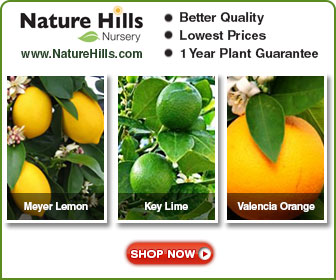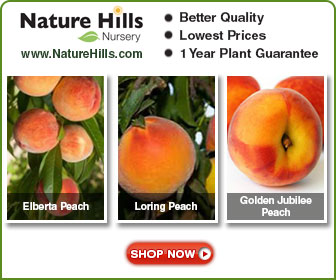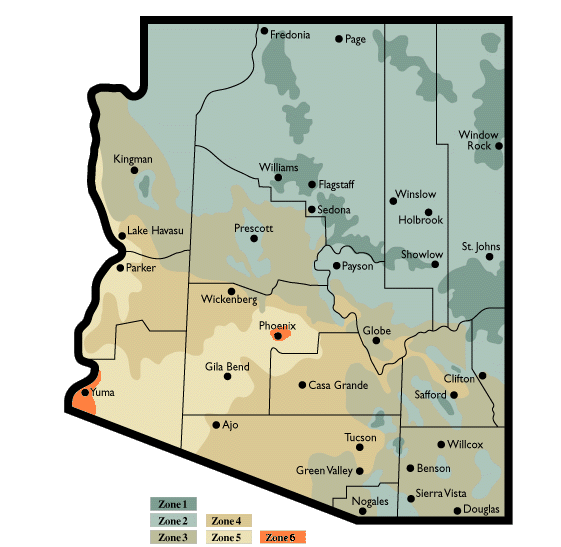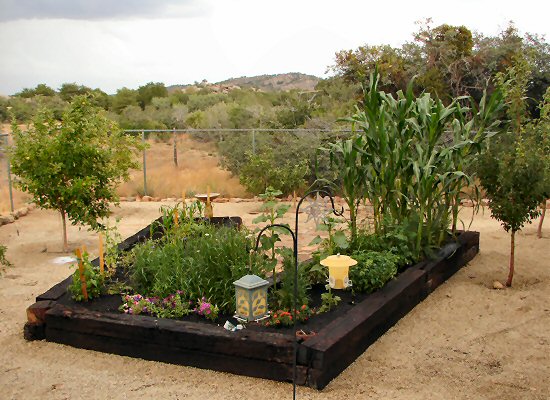



Arizona Vegetable & Fruit Gardening
For The Arizona Desert Environment
Pictures, Photos, Images, Descriptions, & Reviews.
George & Eve Delange

|
All Links Below ( With An * ) Lead To Active Pages, Click On A Link To Bring Up An Active Page.
Common Arizona Garden Plants On Right Of Photo With Red Links.
Many Other Garden Plants Under Photo With Blue Links
They Are Listed By Their Common Name Or Scientific Name.
The above photo is of our main raised bed garden made with railroad ties; at our primary home in beautiful Yarnell, Arizona at 4,864 feet elevation. We have a total of four raised bed gardens made of railroad ties and four raised bed gardens made of large stones. All are irrigated by a managed drip system, on a timer that controls the amount of water the plants receive. Occasionally, we also need to spray the gardens with a hose.
The 6 foot high fence keeps deer, javalina, fox, and coyotes out of the yard, but not mountain lions, bob cats, squirrels, skunks, snakes, and birds. The squirrels, skunks, snakes, and birds love our garden!
Raised bed gardening is one of the best ways to do gardening in Arizona, since the builder has control over the quality of the soil and the amount of water that will be used in the garden.
This bed was built in May of 2011. The plants that are growing were planted as seeds, crowns, or roots in May and the first half of June of 2011.
The above photo was taken on July 8, 2011. You can see how rapidly they have grown during that period of time.
Notice that it looks wet in this photo. One of our Arizona Monsoon Showers had just come through the area. It lasted about 25 minutes and dropped our temperature from 86 degrees F to 62 degrees F in that time. It also gave us .27 inches of rain. The humidity increased from 16 % to 85% during that time period.
Note: By midnight of July 8, 2011; which was about 7 1/2 hours after the Monsoon Shower came through it rained a total of 1.07 inches. This was a "mild" Monsoon Shower. Phoenix had one huge "Haboob" Dust Storm three days earlier on the 5th of July; which they are still cleaning up from.
On July 5, 2011 the 8,000 foot high, 50 mile wide dust storm began in Tuscon, Arizona flew over Phoenix, almost 100 miles away, and left over 10,000 people without power and grounded planes for almost 2 hours. Do a Google search for the storm to see photos and video. It is amazing!
George deLange has lived in the area since 1940 and while he has not seen a storm like this in over 30 years, he had seen several in the 1940's through the 1950's.
The fruit trees surrounding our garden are all dwarf or semi - dwarf trees. They include "Cameo," "Fuji," and "Gala" Apples. There are also some "Delicious" and "Moonglow" Pears, and some "North Star" and "Stark Crimson" Cherry trees in the garden. There also are some "Thompson Seedless" Grapes near our fence.
They all have produced fruit and last year we had about 3 bushels of apples. We forgot to "net" the Cherry Trees last year, so the birds gobbled them up! We didn't even get one for ourselves! We didn't make that mistake this year, so the greedy birds will just have to watch!
Since our garden in Yarnell, Arizona is located at 4,864 feet elevation; that places it into either the Arizona Cooperative Extension Zone Map Zone 2 or 3. Or USDA Zone 7b, 8a, or 8b. Or Sunset National Garden Zone 2 or 10. So you can see why everyone seems to get confused about Zone Maps.
Zone 2: at 4000 to 6000 feet elevation, corresponds to USDA zone 7b and 8a, Sunset National Garden zone 2.
Zone 3: at 3500 to 5000 feet elevation, corresponds to USDA zone 8b, Sunset National Garden zone 10.
We have placed a Zone Map from the Arizona Cooperative Extension Office on this page to help you to figure out which Zone you are in.
If you want to check out what zone you are actually in; you can look up (type in your zip code) your USDA cold hardiness zone at the United States National Arboretum map. Canada is included in this USDA map, but you might also like this Canadian map.
Special Note:
Those of us who live in the Southwest, especially Arizona, know of the insect problems such as Scorpions, & Tarantulas. Then there are other annoying insects such as Ants!
The most effective poison we have found is any poison that contains Bifenthrin 7.9 %. Bifenthrin 7.9 % seems to be the strongest % sold on the matrket.
We have found that Bifen IT is the least expensive poison on the market that contains Bifenthrin 7.9 %.
We have referred several of our neighbors to a company that is online that sells Bifen IT. They have tried it, and they LOVE Bifen IT. No More Scorpions !!! No More Tarantulas !!!
One neighbor used to go out often at night with a black light to find scorpions. He would find about 20 in an hour. Now, he says he can't find any. That is because he sprays his whole property with Bifen IT.
He says "the price is cheap, and it works for about 3 months. so, it is a cheap way to keep my whole property clear of harmful insects!" "But, if you have heavy rain, you may have to repeat the spraying."
Well, We've followed his advice and we spray our whole property now, and NO MORE SCORPIONS!
By the way, when we first used Bifen IT, we would find a dead scorpion on occasion. But, they had only walked about 4 inches onto the area we sprayed, and they died! The sprayed area would last for about 3 months.
Bifen IT, is a great insecticide for the money !!!
The company online that we have referred our neighbors to is DoMyOwnPestControl.com
WE have placed links on our web pages to DoMyOwnPestControl.com We have found them to be an excellent company to do business with.
Below Are Ads For
Insecticides, Fungusides, & Sprayers
Sold Through Amazon.Com That We Can Recommend,
Click On The Item For A More Detailed Look. No Obligation!
We Buy Our Hard To Find Fruit Trees For Yarnell Arizona At Nature Hills Nursery.
We Have Several Nice Fruit Trees Growing In Yarnell, Arizona.
They Will Do Well In Other Similar Elevations In Arizona. ie.. Prescott, Cottonwood, Camp Verde, Sedona.
Cameo & Fuji Apples! Yummm! Click The Nature Hills Nursery Link To View.
 /
/


The author of this page; George DeLange, has lived in the Glendale Arizona area for most of his life, beginning in 1940, and members of his immediate & extended family have been involved in some form of agriculture in the Glendale & Phoenix area since about 1916.
One of George�s earliest memories is of driving a tractor on his family farm, located near present day 67th Avenue and Camelback Road, in Glendale. George was about ten years old at that time.
His grandfather, John Oliver Hawkins, or J.O. as everyone called him, raised watermelons, cantaloupe, lettuce, alfalfa, milo, silage, Chickens, and later on cattle; for his dairy farm, which sold milk to Glendale�s local milk packaging company called "Websters Dairy".
Another relative, Floyd Hawkins, became the President of the Arizona Farm Bureau and served as President for over 16 years.
Another relative owns one of the largest egg producing businesses in the United States, and the largest egg producing company in Arizona, the Hickman's Family Farms.
While George was interested in all types of agriculture; George�s main interest in agriculture was in beekeeping.
George and his friend Al Weichold kept honey bees in the Phoenix and Glendale, Arizona area from about 1966 to about 1992. During that time they learned a lot about how to produce honey in Arizona.
One of the secrets of producing honey was to follow the "honeyflow" which is the opening of the flowers that produced the nectar that the bees turned into honey. Thus, George and Al had to know the flowering plants of Arizona and when the flowering plants would bloom. They also had to know which plants would not produce honey.
George also taught High School Life Science and Environmental Science from 1983 until 2003 in the Phoenix Area.
George will present on the following pages what he has learned about gardening in Arizona as a former Farm Boy, Beekeeper, and Life Science Instructor. No attempt is being made here to present a detailed scientific page on the subject. Every gardening plant in Arizona will not be shown. George hopes that these pages might be simply of interest to anyone who wants to learn about gardening in Arizona.
Over the past sixty years Phoenix has become less agricultural and more urban. George still lives in the Glendale area, in an urban neighborhood about a quarter mile from where he kept his bees. George never thought that population changes would have affected the Glendale and Peoria area as much as it has done!
Glendale and Peoria have certainly grown. People now are afraid of Honeybees. Laws have been passed outlawing beekeeping in urban areas. George often wonders; since bees are absolutely necessary for much of our food production, what will be our future without bees?
Another practice that he wonders about, is that over the 70 years he has lived in the Greater Phoenix Area, almost all of the very rich agricultural land has been covered with cement and buildings as the area has grown.
Where will our food come from?
One good place would of course be our own home gardens.
And, George also knows that there are several reasons to grow our own gardens. Such as; gardening is simply an enjoyable hobby, home grown foods taste better, a home garden saves food money, homegrown foods are more nutritious, home gardens protect the environment, and home gardening can also be a fun learning activity for our children.
THIS PAGE IS UNDER CONSTRUCTION; PLEASE, COME BACK LATER FOR A MORE DETAILED SITE ABOUT ARIZONA VEGETABLE & FRUIT GARDENING.

Arizona Climate Zones Map
For Vegetable Gardens Of The Arizona Desert Environment.
Courtesy Of The University of Arizona
Elizabeth Davison, Lecturer, Department of Plant Sciences.
Zone Maps can be confusing??
What are Zone Maps?
Gardeners need a way to compare their garden climates with the climate where a plant is known to grow well. That's why climate zone maps were created. Zone maps are tools that show where various permanent landscape plants can adapt. If you want a shrub, perennial, or tree to survive and grow year after year, the plant must tolerate year-round conditions in your area, such as the lowest and highest temperatures and the amount and distribution of rainfall.
The 1990 USDA Hardiness Zone Map?
Therefore, the USDA Hardiness Zone Map is one of several maps which were developed to provide this critical climate information to gardners. The USDA map is the map that most gardeners in the eastern United States rely on, and the one that most national garden magazines, catalogs, books, and several nurseries currently use. The USDA Hardiness Zone Map divides North America into 11 separate zones. Each zone is 10?F warmer (or colder) in an average winter than the adjacent zone. (In some versions of the map, each zone is further divided into an "a" and "b" region.)
The 1990 USDA Hardiness Zone Map is great for use in the Eastern USA:
The Eastern USA is comparatively flat, so mapping is mostly a matter of drawing lines approximately parallel to the Gulf Coast every 120 miles or so as you move north. The lines tilt northeast as they approach the Eastern Seaboard. They also demarcate the special climates formed by the Great Lakes and by the Appalachian mountain ranges.
Zone Map Shortcomings!
But the USDA Hardiness Zone Map has serious shortcomings for the rest of the USA.
In the eastern half of the country, the USDA map doesn't account for the beneficial effect of a snow cover over perennial plants, the regularity or absence of freeze-thaw cycles, or soil drainage during cold periods. And in the rest of the country (west of the 100th meridian, which runs roughly through the middle of North and South Dakota and down through Texas west of Laredo), the USDA map fails.
Problems in the West:
Many factors beside winter lows, such as elevation and precipitation, determine western growing climates in the West.
Weather comes in from the Pacific Ocean and gradually becomes less marine (humid) and more continental (drier) as it moves over and around mountain range after mountain range.
While cities in similar zones in the East can have similar climates and grow similar plants, in the West it varies greatly. For example, the weather and plants in low elevation, coastal Seattle are much different than in high elevation, inland Tucson, Arizona, even though they're in the same zone USDA zone 8.
To try to refine and produce a better Zone Map; Sunset Books (associated with Sunset Magazine) publishes a series that break up climate zones more finely than the USDA zones. They identify 45 distinct zones in the US, incorporating ranges of temperatures in all seasons, precipitation, wind patterns, elevation, and length and structure of the growing season.
In Arizona:
The Cooperative Extension, College of Agriculture & Life Sciences, of The University of Arizona, developed the map shown in the above image. It breaks down the zones in Arizona and compares them to the USDA Hardiness Zone Map and the Sunset National Garden Zone
Map. It breaks down the three Zone Maps and compares them as follows....
Zone 1: over 6000 feet elevation, corresponds to USDA zone 7 or colder, Sunset National Garden zone 1.
Zone 2: at 4000 to 6000 feet elevation, corresponds to USDA zone 7b and 8a, Sunset National Garden zone 2.
Zone 3: at 3500 to 5000 feet elevation, corresponds to USDA zone 8b, Sunset National Garden zone 10.
Zone 4: at 2000 to 4000 feet elevation, corresponds to USDA zone 9a, Sunset National Garden zone 12.
Zone 5: at 1000 to 2000 feet elevation, corresponds to USDA zone 9b, Sunset National Garden zone 13.
Zone 6: below 1000 feet elevation, and in the warmer areas of the Phoenix metropolitan area, corresponds to USDA zone 10, and the warmest areas of Sunset National Garden zone 13
Most gardeners that we know in Arizona prefer to use the Cooperative Extension Zone Map.
The Cooperative Extension, which is an outreach arm of The University of Arizona, is one of the best resources for information about gardening in Arizona. And they are FREE to use. We are providing a link to their website for your convience at the bottom of this page.
If you want to check out what zone you are actually in; you can look up (type in your zip code) your USDA cold hardiness zone at the United States National Arboretum map. Canada is included in this USDA map, but you might also like this Canadian map.



Click Here To See Free Arizona Sonoran Desert Plants Native Food Recipes.
© 1966 - Present, George & Eve DeLange
We're Glad You Stopped By! Come back soon!
Send E-Mail to: George DeLange: [email protected]
Below Are Ads For Raised Garden Items Sold Through Amazon.Com,
Most Of These Items Are For Someone Who Just Wants To Start
Or For Someone With Just A Small Area To Plant Their Garden
Click On The Item For A More Detailed Look. No Obligation!
Below Are Ads For Garden Items Sold Through Amazon.Com
Click On The Item For A More Detailed Look. No Obligation!
We Are Proud Of Our SafeSurf Rating!



The above photo is of our main raised bed garden made with railroad ties; at our primary home in beautiful Yarnell, Arizona at 4,864 feet elevation. We have a total of four raised bed gardens made of railroad ties and four raised bed gardens made of large stones. All are irrigated by a managed drip system, on a timer that controls the amount of water the plants receive. Occasionally, we also need to spray the gardens with a hose. The 6 foot high fence keeps deer, javalina, fox, and coyotes out of the yard, but not mountain lions, bob cats, squirrels, skunks, snakes, and birds. The squirrels, skunks, snakes, and birds love our garden! Raised bed gardening is one of the best ways to do gardening in Arizona, since the builder has control over the quality of the soil and the amount of water that will be used in the garden. This bed was built in May of 2011. The plants that are growing were planted as seeds, crowns, or roots in May and the first half of June of 2011. The above photo was taken on July 8, 2011. You can see how rapidly they have grown during that period of time. Notice that it looks wet in this photo. One of our Arizona Monsoon Showers had just come through the area. It lasted about 25 minutes and dropped our temperature from 86 degrees F to 62 degrees F in that time. It also gave us .27 inches of rain. The humidity increased from 16 % to 85% during that time period. Note: By midnight of July 8, 2011; which was about 7 1/2 hours after the Monsoon Shower came through it rained a total of 1.07 inches. This was a "mild" Monsoon Shower. Phoenix had one huge "Haboob" Dust Storm three days earlier on the 5th of July; which they are still cleaning up from. On July 5, 2011 the 8,000 foot high, 50 mile wide dust storm began in Tuscon, Arizona flew over Phoenix, almost 100 miles away, and left over 10,000 people without power and grounded planes for almost 2 hours. Do a Google search for the storm to see photos and video. It is amazing! George deLange has lived in the area since 1940 and while he has not seen a storm like this in over 30 years, he had seen several in the 1940's through the 1950's. The fruit trees surrounding our garden are all dwarf or semi - dwarf trees. They include "Cameo," "Fuji," and "Gala" Apples. There are also some "Delicious" and "Moonglow" Pears, and some "North Star" and "Stark Crimson" Cherry trees in the garden. There also are some "Thompson Seedless" Grapes near our fence. They all have produced fruit and last year we had about 3 bushels of apples. We forgot to "net" the Cherry Trees last year, so the birds gobbled them up! We didn't even get one for ourselves! We didn't make that mistake this year, so the greedy birds will just have to watch! Since our garden in Yarnell, Arizona is located at 4,864 feet elevation; that places it into either the Arizona Cooperative Extension Zone Map Zone 2 or 3. Or USDA Zone 7b, 8a, or 8b. Or Sunset National Garden Zone 2 or 10. So you can see why everyone seems to get confused about Zone Maps. Zone 2: at 4000 to 6000 feet elevation, corresponds to USDA zone 7b and 8a, Sunset National Garden zone 2. Zone 3: at 3500 to 5000 feet elevation, corresponds to USDA zone 8b, Sunset National Garden zone 10. We have placed a Zone Map from the Arizona Cooperative Extension Office on this page to help you to figure out which Zone you are in.
If you want to check out what zone you are actually in; you can look up (type in your zip code) your USDA cold hardiness zone at the United States National Arboretum map. Canada is included in this USDA map, but you might also like this Canadian map.
|
Special Note: Those of us who live in the Southwest, especially Arizona, know of the insect problems such as Scorpions, & Tarantulas. Then there are other annoying insects such as Ants! The most effective poison we have found is any poison that contains Bifenthrin 7.9 %. Bifenthrin 7.9 % seems to be the strongest % sold on the matrket. We have found that Bifen IT is the least expensive poison on the market that contains Bifenthrin 7.9 %. We have referred several of our neighbors to a company that is online that sells Bifen IT. They have tried it, and they LOVE Bifen IT. No More Scorpions !!! No More Tarantulas !!! One neighbor used to go out often at night with a black light to find scorpions. He would find about 20 in an hour. Now, he says he can't find any. That is because he sprays his whole property with Bifen IT. He says "the price is cheap, and it works for about 3 months. so, it is a cheap way to keep my whole property clear of harmful insects!" "But, if you have heavy rain, you may have to repeat the spraying." Well, We've followed his advice and we spray our whole property now, and NO MORE SCORPIONS! By the way, when we first used Bifen IT, we would find a dead scorpion on occasion. But, they had only walked about 4 inches onto the area we sprayed, and they died! The sprayed area would last for about 3 months. Bifen IT, is a great insecticide for the money !!! The company online that we have referred our neighbors to is DoMyOwnPestControl.com
WE have placed links on our web pages to DoMyOwnPestControl.com We have found them to be an excellent company to do business with.
|
Insecticides, Fungusides, & Sprayers
Sold Through Amazon.Com That We Can Recommend,
Click On The Item For A More Detailed Look. No Obligation!
We Buy Our Hard To Find Fruit Trees For Yarnell Arizona At Nature Hills Nursery.
We Have Several Nice Fruit Trees Growing In Yarnell, Arizona.
They Will Do Well In Other Similar Elevations In Arizona. ie.. Prescott, Cottonwood, Camp Verde, Sedona.
Cameo & Fuji Apples! Yummm! Click The Nature Hills Nursery Link To View.
 /
/

The author of this page; George DeLange, has lived in the Glendale Arizona area for most of his life, beginning in 1940, and members of his immediate & extended family have been involved in some form of agriculture in the Glendale & Phoenix area since about 1916. One of George�s earliest memories is of driving a tractor on his family farm, located near present day 67th Avenue and Camelback Road, in Glendale. George was about ten years old at that time. His grandfather, John Oliver Hawkins, or J.O. as everyone called him, raised watermelons, cantaloupe, lettuce, alfalfa, milo, silage, Chickens, and later on cattle; for his dairy farm, which sold milk to Glendale�s local milk packaging company called "Websters Dairy". Another relative, Floyd Hawkins, became the President of the Arizona Farm Bureau and served as President for over 16 years. Another relative owns one of the largest egg producing businesses in the United States, and the largest egg producing company in Arizona, the Hickman's Family Farms. While George was interested in all types of agriculture; George�s main interest in agriculture was in beekeeping. George and his friend Al Weichold kept honey bees in the Phoenix and Glendale, Arizona area from about 1966 to about 1992. During that time they learned a lot about how to produce honey in Arizona. One of the secrets of producing honey was to follow the "honeyflow" which is the opening of the flowers that produced the nectar that the bees turned into honey. Thus, George and Al had to know the flowering plants of Arizona and when the flowering plants would bloom. They also had to know which plants would not produce honey. George also taught High School Life Science and Environmental Science from 1983 until 2003 in the Phoenix Area. George will present on the following pages what he has learned about gardening in Arizona as a former Farm Boy, Beekeeper, and Life Science Instructor. No attempt is being made here to present a detailed scientific page on the subject. Every gardening plant in Arizona will not be shown. George hopes that these pages might be simply of interest to anyone who wants to learn about gardening in Arizona. Over the past sixty years Phoenix has become less agricultural and more urban. George still lives in the Glendale area, in an urban neighborhood about a quarter mile from where he kept his bees. George never thought that population changes would have affected the Glendale and Peoria area as much as it has done! Glendale and Peoria have certainly grown. People now are afraid of Honeybees. Laws have been passed outlawing beekeeping in urban areas. George often wonders; since bees are absolutely necessary for much of our food production, what will be our future without bees? Another practice that he wonders about, is that over the 70 years he has lived in the Greater Phoenix Area, almost all of the very rich agricultural land has been covered with cement and buildings as the area has grown. Where will our food come from? One good place would of course be our own home gardens. And, George also knows that there are several reasons to grow our own gardens. Such as; gardening is simply an enjoyable hobby, home grown foods taste better, a home garden saves food money, homegrown foods are more nutritious, home gardens protect the environment, and home gardening can also be a fun learning activity for our children.
|
THIS PAGE IS UNDER CONSTRUCTION; PLEASE, COME BACK LATER FOR A MORE DETAILED SITE ABOUT ARIZONA VEGETABLE & FRUIT GARDENING.
|
 |
| Arizona Climate Zones Map For Vegetable Gardens Of The Arizona Desert Environment. Courtesy Of The University of Arizona Elizabeth Davison, Lecturer, Department of Plant Sciences. |
|---|
Zone Maps can be confusing??
What are Zone Maps?
The 1990 USDA Hardiness Zone Map?
The 1990 USDA Hardiness Zone Map is great for use in the Eastern USA:
Zone Map Shortcomings!
In the eastern half of the country, the USDA map doesn't account for the beneficial effect of a snow cover over perennial plants, the regularity or absence of freeze-thaw cycles, or soil drainage during cold periods. And in the rest of the country (west of the 100th meridian, which runs roughly through the middle of North and South Dakota and down through Texas west of Laredo), the USDA map fails.
Problems in the West:
Weather comes in from the Pacific Ocean and gradually becomes less marine (humid) and more continental (drier) as it moves over and around mountain range after mountain range. While cities in similar zones in the East can have similar climates and grow similar plants, in the West it varies greatly. For example, the weather and plants in low elevation, coastal Seattle are much different than in high elevation, inland Tucson, Arizona, even though they're in the same zone USDA zone 8. To try to refine and produce a better Zone Map; Sunset Books (associated with Sunset Magazine) publishes a series that break up climate zones more finely than the USDA zones. They identify 45 distinct zones in the US, incorporating ranges of temperatures in all seasons, precipitation, wind patterns, elevation, and length and structure of the growing season.
In Arizona:
Zone 1: over 6000 feet elevation, corresponds to USDA zone 7 or colder, Sunset National Garden zone 1. Zone 2: at 4000 to 6000 feet elevation, corresponds to USDA zone 7b and 8a, Sunset National Garden zone 2. Zone 3: at 3500 to 5000 feet elevation, corresponds to USDA zone 8b, Sunset National Garden zone 10. Zone 4: at 2000 to 4000 feet elevation, corresponds to USDA zone 9a, Sunset National Garden zone 12. Zone 5: at 1000 to 2000 feet elevation, corresponds to USDA zone 9b, Sunset National Garden zone 13. Zone 6: below 1000 feet elevation, and in the warmer areas of the Phoenix metropolitan area, corresponds to USDA zone 10, and the warmest areas of Sunset National Garden zone 13 Most gardeners that we know in Arizona prefer to use the Cooperative Extension Zone Map. The Cooperative Extension, which is an outreach arm of The University of Arizona, is one of the best resources for information about gardening in Arizona. And they are FREE to use. We are providing a link to their website for your convience at the bottom of this page.
If you want to check out what zone you are actually in; you can look up (type in your zip code) your USDA cold hardiness zone at the United States National Arboretum map. Canada is included in this USDA map, but you might also like this Canadian map.
|



| © 1966 - Present, George & Eve DeLange |
We're Glad You Stopped By! Come back soon!
Most Of These Items Are For Someone Who Just Wants To Start
Or For Someone With Just A Small Area To Plant Their Garden
Click On The Item For A More Detailed Look. No Obligation!
Click On The Item For A More Detailed Look. No Obligation!
We Are Proud Of Our SafeSurf Rating!






